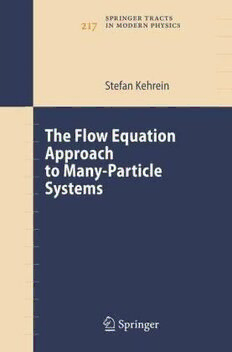Table Of ContentSpringer Tracts in Modern Physics
Volume 217
ManagingEditor:G.Höhler,Karlsruhe
Editors: A.Fujimori,Chiba
C.Varma,California
F.Steiner,Ulm
J.Kühn,Karlsruhe
J.Trümper,Garching
P.Wölfle,Karlsruhe
Th.Müller,Karlsruhe
StartingwithVolume165,SpringerTractsinModernPhysicsispartofthe[SpringerLink]service.
ForallcustomerswithstandingordersforSpringerTractsinModernPhysicsweofferthefulltext
inelectronicformvia[SpringerLink]freeofcharge.Pleasecontactyourlibrarianwhocanreceive
apasswordforfreeaccesstothefullarticlesbyregistrationat:
springerlink.com
Ifyoudonothaveastandingorderyoucanneverthelessbrowseonlinethroughthetableofcontents
ofthevolumesandtheabstractsofeacharticleandperformafulltextsearch.
Thereyouwillalsofindmoreinformationabouttheseries.
Springer Tracts in Modern Physics
SpringerTractsinModernPhysicsprovidescomprehensiveandcriticalreviewsoftopicsofcurrentin-
terestinphysics.Thefollowingfieldsareemphasized:elementaryparticlephysics,solid-statephysics,
complexsystems,andfundamentalastrophysics.
Suitablereviewsofotherfieldscanalsobeaccepted.Theeditorsencourageprospectiveauthorstocor-
respond with them in advance of submitting an article. For reviews of topics belonging to the above
mentionedfields,theyshouldaddresstheresponsibleeditor,otherwisethemanagingeditor.
Seealsospringer.com
ManagingEditor Solid-StatePhysics,Editors
GerhardHöhler AtsushiFujimori
EditorforThePacificRim
InstitutfürTheoretischeTeilchenphysik
UniversitätKarlsruhe DepartmentofComplexityScience
Postfach6980 andEngineering
76128Karlsruhe,Germany UniversityofTokyo
Phone:+49(721)6083375 GraduateSchoolofFrontierSciences
Fax:+49(721)370726 5-1-5Kashiwanoha
Email:gerhard.hoehler@physik.uni-karlsruhe.de Kashiwa,Chiba277-8561,Japan
www-ttp.physik.uni-karlsruhe.de/ Email:fujimori@k.u-tokyo.ac.jp
http://wyvern.phys.s.u-tokyo.ac.jp/welcome_en.html
ElementaryParticlePhysics,Editors C.Varma
JohannH.Kühn EditorforTheAmericas
InstitutfürTheoretischeTeilchenphysik DepartmentofPhysics
UniversitätKarlsruhe UniversityofCalifornia
Postfach6980 Riverside,CA92521
76128Karlsruhe,Germany Phone:+1(951)827-5331
Phone:+49(721)6083372 Fax:+1(951)827-4529
Fax:+49(721)370726 Email:chandra.varma@ucr.edu
Email:johann.kuehn@physik.uni-karlsruhe.de www.physics.ucr.edu
www-ttp.physik.uni-karlsruhe.de/∼jk PeterWölfle
ThomasMüller
InstitutfürTheoriederKondensiertenMaterie
InstitutfürExperimentelleKernphysik UniversitätKarlsruhe
FakultätfürPhysik Postfach6980
UniversitätKarlsruhe 76128Karlsruhe,Germany
Postfach6980 Phone:+49(721)6083590
76128Karlsruhe,Germany Fax:+49(721)698150
Phone:+49(721)6083524 Email:woelfle@tkm.physik.uni-karlsruhe.de
Fax:+49(721)6072621 www-tkm.physik.uni-karlsruhe.de
Email:thomas.muller@physik.uni-karlsruhe.de
www-ekp.physik.uni-karlsruhe.de ComplexSystems,Editor
FrankSteiner
FundamentalAstrophysics,Editor
AbteilungTheoretischePhysik
JoachimTrümper
UniversitätUlm
Max-Planck-InstitutfürExtraterrestrischePhysik Albert-Einstein-Allee11
Postfach1312 89069Ulm,Germany
85741Garching,Germany Phone:+49(731)5022910
Phone:+49(89)30003559 Fax:+49(731)5022924
Fax:+49(89)30003315 Email:frank.steiner@uni-ulm.de
Email:jtrumper@mpe.mpg.de www.physik.uni-ulm.de/theo/qc/group.html
www.mpe-garching.mpg.de/index.html
Stefan Kehrein
The Flow Equation
Approach to
Many-Particle Systems
With24Figures
ABC
StefanKehrein
Ludwig-Maximilians-UniversitätMünchen
FakultätfürPhysik
Theresienstr.37
80333München
Germany
E-mail:stefan.kehrein@physik.Imu.de
LibraryofCongressControlNumber:2006925894
PhysicsandAstronomyClassificationScheme(PACS):
01.30.mm,05.10.Cc,71.10.-w
ISSNprintedition:0081-3869
ISSNelectronicedition:1615-0430
ISBN-10 3-540-34067-XSpringerBerlinHeidelbergNewYork
ISBN-13 978-3-540-34067-6SpringerBerlinHeidelbergNewYork
Thisworkissubjecttocopyright.Allrightsarereserved,whetherthewholeorpartofthematerialis
concerned,specificallytherightsoftranslation,reprinting,reuseofillustrations,recitation,broadcasting,
reproductiononmicrofilmorinanyotherway,andstorageindatabanks.Duplicationofthispublication
orpartsthereofispermittedonlyundertheprovisionsoftheGermanCopyrightLawofSeptember9,
1965,initscurrentversion,andpermissionforusemustalwaysbeobtainedfromSpringer.Violationsare
liableforprosecutionundertheGermanCopyrightLaw.
SpringerisapartofSpringerScience+BusinessMedia
springer.com
(cid:1)c Springer-VerlagBerlinHeidelberg2006
PrintedinTheNetherlands
Theuseofgeneraldescriptivenames,registerednames,trademarks,etc.inthispublicationdoesnotimply,
evenintheabsenceofaspecificstatement,thatsuchnamesareexemptfromtherelevantprotectivelaws
andregulationsandthereforefreeforgeneraluse.
Typesetting:bytheauthorusingaSpringerLATEXmacropackage
Coverconcept:eStudioCalamarSteinen
Coverproduction:design&productionGmbH,Heidelberg
Printedonacid-freepaper SPIN:10985205 56/techbooks 543210
To Michelle
Preface
Overthepastdecade,theflowequationmethodhasdevelopedintoanewver-
satiletheoreticalapproachtoquantummany-bodyphysics.Itsbasicconcept
wasconceived independentlybyWegner[1]andbyGl(cid:1)azekandWilson[2,3]:
the derivation of a unitary flow that makes a many-particle Hamiltonian in-
creasingly energy-diagonal. This concept can be seen as a generalization of
theconventionalscalingapproachesinmany-bodyphysics,wheresomeultra-
violetenergyscaleislowereddowntotheexperimentallyrelevantlow-energy
scale[4].Themaindifferencebetweentheconventionalscalingapproachand
the flow equation approach can then be traced back to the fact that the
flow equation approach retains all degrees of freedom, i.e. the full Hilbert
space, while the conventional scaling approach focusses on some low-energy
subspace. One useful feature of the flow equation approach is therefore that
it allows the calculation of dynamical quantities on all energy scales in one
unified framework.
Since its introduction, a substantial body of work using the flow equa-
tion approach has accumulated. It was used to study a number of very dif-
ferent quantum many-body problems from dissipative quantum systems to
correlated electron physics. Recently, it also became apparent that the flow
equation approach is very suitable for studying quantum many-body non-
equilibrium problems, which form one of the current frontiers of modern
theoretical physics. Therefore the time seems ready to compile the research
literatureonflowequationsinaconsistentandaccessibleway,whichwasmy
goal in writing this book.
The choice of material presented here is necessarily subjective and moti-
vatedbymyownresearchinterests.Still,Ibelievethattheworkcompiledin
this book provides a pedagogical introduction to the flow equation method
from simple to complex models while remaining faithful to its nonpertur-
bative character. Most of the models and examples in this book come from
condensed matter theory, and a certain familiarity with modern condensed
matter theory will be helpful in working through this book.1 Purposely, this
bookisfocussedonthemethodandnotonthephysicalbackgroundandmoti-
vationofthemodelsdiscussed.Byworkingthroughit,astudentorresearcher
1An excellent and highly recommended introduction is, for example, P.W. An-
derson’s classic textbook [4].
VIII Preface
shouldbecomewellequippedtoinvestigatemodelsofone’sowninterestusing
the flow equation approach. Most of the derivations are worked out in con-
siderable detail, and I recommend to study them thoroughly to learn about
the application and potential pitfalls of the flow equation approach.
Theflowequationapproachisunderactivedevelopmentandmanyissues
still need to be addressed and answered. I hope that this book will motivate
its readers to contribute to these developments. I will try to keep track of
such developments on my Internet homepage, and hope for e-mail feedback
from the readers of this book. In particular, I am grateful for mentioning
typos, which will be compiled on my homepage.
Both in my research on flow equations and in writing the present book,
I owe debts of gratitude to numerous colleagues. First of all, I am deeply
indebted to my Ph.D. advisor Franz Wegner, whose presentation of his new
“flowequationscheme”inourHeidelberggroupseminarin1992startedboth
thiswholelineofresearchandmyinvolvementinit.Ialsooweaveryspecial
acknowledgment to Andreas Mielke, with whom I have started my work on
flowequationsbackin1994.Ourjointworkhassetthefoundationsofmanyof
thedevelopments presentedinthisbook.Duringmyworkonflowequations,
I have also profited greatly from many discussions with Dieter Vollhardt. I
amparticularlygratefultohimforhiscontinuedinterestandencouragement.
I also thank the participants of my flow equation lecture in Augsburg
during the summer term 2005, which gave me the opportunity to test my
presentation of the material that is compiled in this book. Among them I
am especially thankful to Peter Fritsch, Lars Fritz, Andreas Hackl, Verena
Ko¨rting, and Michael Mo¨ckel for proofreading parts of this manuscript.
TheoriginalideatowritethisbookisduetoasuggestionbyPeterWo¨lfle,
and I am very grateful to him for starting me on this project and for his
continuedinterestintheflowequationapproachingeneral.Thisbookproject
and a lot of the research compiled in it has only been possible due to a
Heisenberg fellowship of the Deutsche Forschungsgemeinschaft (DFG). This
gave me the necessary free time to pursue this project, and it is pleasure to
acknowledge the DFG for this generous and unbureaucratic support through
the Heisenberg program.
Finally, I thank my colleagues at the University of Augsburg for many
valuable discussions, and everyone else not mentioned here by name with
whom I have worked on flow equations in the past decade.
For everything else and much more, I thank Michelle.
Augsburg Stefan Kehrein
February 2006
References IX
References
1. F. Wegner, Ann. Phys. (Leipzig) 3, 77 (1994)
2. S.D. G(cid:1)lazek and K.G. Wilson, Phys. Rev. D 48, 5863 (1993)
3. S.D. G(cid:1)lazek and K.G. Wilson, Phys. Rev. D 49, 4214 (1994)
4. P.W.Anderson:BasicNotionsofCondensedMatterPhysics,6thedn(Addison-
Wesley, Reading Mass. 1996)
Contents
1 Introduction.............................................. 1
1.1 Motivation ............................................ 1
1.2 Flow Equations: Basic Ideas ............................. 2
1.3 Outline and Scope of this Book .......................... 7
References ................................................. 9
2 Transformation of the Hamiltonian ....................... 11
2.1 Energy Scale Separation................................. 11
2.1.1 Potential Scattering Model ........................ 12
2.1.2 Kondo Model .................................... 19
2.2 Flow Equation Approach ................................ 22
2.2.1 Motivation ...................................... 22
2.2.2 Infinitesimal Unitary Transformations............... 23
2.2.3 Choice of Generator .............................. 25
2.2.4 Flow Equations .................................. 28
2.3 Example: Potential Scattering Model...................... 31
2.3.1 Setting up the Flow Equations ..................... 31
2.3.2 Methods of Solution .............................. 34
2.3.3 Strong-Coupling Case............................. 39
References ................................................. 40
3 Evaluation of Observables ................................ 43
3.1 Expectation Values ..................................... 43
3.1.1 Zero Temperature ................................ 43
3.1.2 Nonzero Temperature............................. 46
3.2 Correlation Functions ................................... 47
3.2.1 Zero Temperature ................................ 47
3.2.2 Nonzero Temperature............................. 49
3.2.3 Fluctuation–Dissipation Theorem .................. 50
3.3 Examples.............................................. 51
3.3.1 Potential Scattering Model ........................ 52
3.3.2 Resonant Level Model ............................ 54
References ................................................. 61

